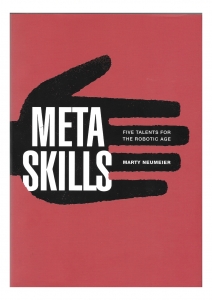The one sentence summary
As the robot age decreases the value of much work, we need to enhance our metaskills – feeling, seeing, dreaming, making, and learning.
WHAT THE BOOK SAYS 
- We need five talents for the robotic age. These are metacognitive skills or metaskills: guiding principles that can be transferred from one situation to another. They determine the how to, not the what to:
- Feeling: empathy and intuition
- Seeing: systems, thinking harder and better
- Dreaming: applied imagination
- Making: design and testing
- Learning: autodidactics (self-teaching)
- The robot curve shows the value and cost of work decreasing with mechanisation:
Creative work – unique, imaginative, non-routine, autonomous
Skilled work – standardised, talent driven, professional, directed
Rote work – interchangeable, routinized, outsourceable, managed
Robotic work – algorithmic, computerised, efficient, purchased
- The internet is creating a collective conscious – a fourth brain on top of the three we already have.
- We need to reject the tyranny of or and embrace the genius of and. Leave the sides behind and look for a third narrative based on common ground.
- Originality uses imagination and knowledge in four ways: new to yourself, new to the world, adapted from the same domain, or from another. It lies somewhere in the intersection between economy, simplicity, delight, novelty, utility, and credibility.
WHAT’S GOOD ABOUT IT
- Elements of beauty are surprise, rightness and elegance.
- The layers of aesthetics are content, form and associations.
- In the latency trap, you see a problem, introduce a change, nothing happens, you increase the change, and the problem gets worse.
- Creativity actually comes from a no-process process: confusion, clutter, chaos, crisis, catharsis.
- The discipline of uncluding is subtracting every element that doesn’t pull its weight. Everyone can include or exclude, but few can unclude.
- Complexity and simplicity are actually fighting on the same side. They both seek to increase order, one by addition, the other by subtraction. Simplexity opposes disorder, entropy, and messiness.
- According to geneticist J. B. S. Haldane, there are 4 stages to acceptance to new ideas: from “worthless nonsense”, to “interesting but perverse”, to “true, but unimportant”, to “I always said so.”
- Connecting two previously unconnected thoughts is a form of combinatory play. “A genius is a person who has two great ideas.” Jacob Bronowski
- “Without solitude, no serious work is possible.” Picasso
WHAT YOU HAVE TO WATCH
- Nothing. This is thought-provoking stuff.
